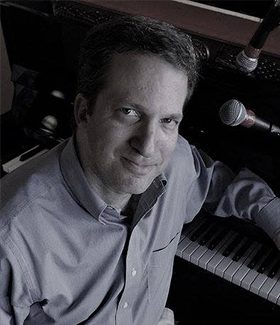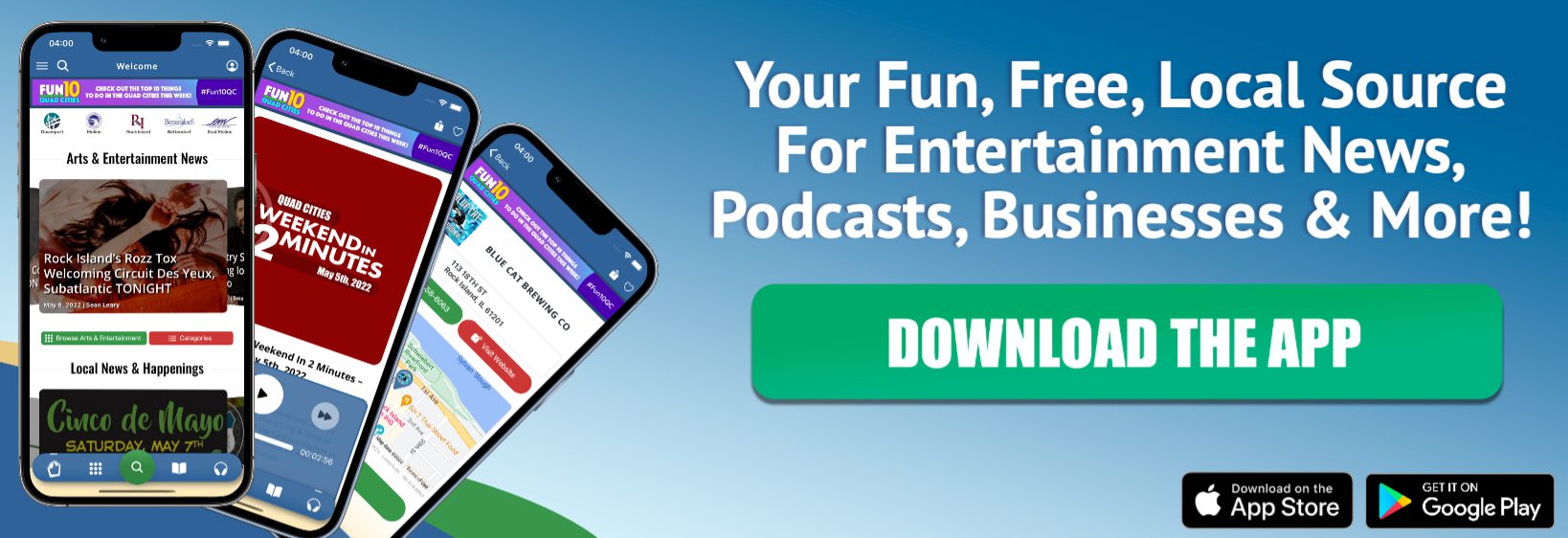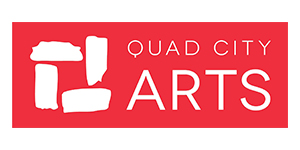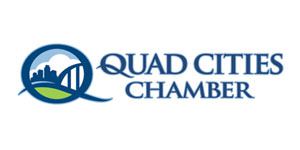“It’s Definitely Different”: Quad City Symphony Orchestra Conductor Adjusts To Covid Restrictions
What a difference an audience makes. Any performer – especially in this dizzying, chaotic age of Covid-19 – knows this.
And when Mark Russell Smith, starting his 12th season as music director and conductor of the Quad City Symphony Orchestra, took to the Adler Theatre stage Oct. 3 for the first time in seven months – he knew it for sure.

Mark Russell Smith is in his 12th season as music director and conductor of the Quad City Symphony Orchestra.
“It was moving, very powerful,” he said Thursday of leading a smaller, socially-distanced ensemble, as he wore a face mask. “Even before we played a note, the audience greeted us with a standing ovation. I came out like normal, the orchestra stood up and the audience stood up and clapped for a really long time. I got choked up; I’m getting choked up just thinking about it.
“The audience was so grateful that we, you know, we were doing it and we did what we needed to do, to be able to do it,” Smith said. “Then of course, the music-making was great also. There’s all sorts of challenges that are created, but it was just great to hear live music, to be on stage with everybody and connect with a live audience.”
As many orchestras nationwide have scrapped part or all their 2020-21 seasons in person, opting for digital concerts, the QCSO was a rarity last month.
They attracted 250 patrons (spread out throughout the Adler) Saturday, Oct. 3, and 150 Sunday, Oct. 4. The orchestra sold more than 200 digital access tickets, with each serving a household (normally two tickets in the hall), able to see a video of the Saturday performance until Nov. 3.
The Sept. 12 Quad City Bank & Trust Riverfront Pops, at LeClaire Park, had 27 orchestra musicians (playing in mask under the baton of assistant conductor Ernesto Estigarribia), backing the guest Fleetwood Mac tribute band, separated by a Plexiglas barrier. The concert attracted 2,000 in the audience, and each party had its own assigned plot – varying in size for two, six or 10 people.

Smith lives in Minneapolis, where he’s been artistic director of orchestral activities at the University of Minnesota since 2007.
A 40-person orchestra will perform at the Adler this Saturday night, but instead of two performances, they’ll play just one, record that and premiere it online at 2 p.m. Sunday, and access will be available for 30 days.
Last month’s Beethoven Symphony No. 1 was a similar size orchestra, with about 10 wind players. Smith said everyone wears a mask, but most wind and brass players can’t wear one while they play, so they’re distanced more from other musicians.
“The precautions are really well thought-out, in terms of spacing and ventilation, and the mask-wearing,” he said Thursday. “There’s all sorts of protocols involved with air flow. It is different – the string players all wear masks, and the wind instruments emit different aerosols, so there are all sorts of rules for that. It’s different for different instruments.”
“It’s really about air flow, what the Adler does to replace the air,” Smith said. The intermission-less concerts are significantly shorter than a typical concert. The conductor agrees with the decision (as in his home base of the Twin Cities) not to have Q-C audiences for the rest of November and December.
“It is disappointing; this whole thing is disappointing, given that the numbers have doubled or tripled,” Smith said of Covid cases. “It’s the responsible thing to do. Yes, we’d rather play for audiences; there’s no doubt about that. And we showed that certainly with the first concert and Riverfront Pops, we’re able to do it
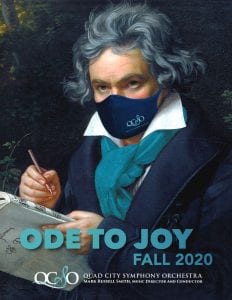
Though it’s not performing “Ode to Joy,” the QCSO is celebrating the 250th anniversary of Beethoven’s birth all this fall.
responsibly, and there were no incidents and everything turned out really well.”
“Now it’s a different situation than it was a month ago,” he said. “I think we have no choice. It is an incredible bummer that we can’t have live audiences, but I’m really glad we can give the virtual concerts we can give.”
Giving the public digital access to the concerts for 30 days also expands the number of people who can see the QCSO, Smith said. They could also reach some audience members who don’t usually attend the symphony, he said.
“It’s the old story – you make lemonade out of the lemons you’ve been given,” he said.
Minnesota Orchestra went all digital from start
The Minnesota Orchestra (where Smith’s wife Ellen is a horn player) is performing six Friday night concerts live this fall, all without audiences, which started Oct. 2. These performances will be available as live TV and radio broadcasts, and livestreamed concerts at minnesotaorchestra.org.
“They have like five full-time horn players, so they divide it up,” Smith said. “She hasn’t played yet, but she’s going to later in November.”
“We’re able, with the space on our stage, to accommodate up to 40 musicians,” he said of the QCSO at the Adler Theatre. “Every place is different. We try to learn from each other as much as we can.”
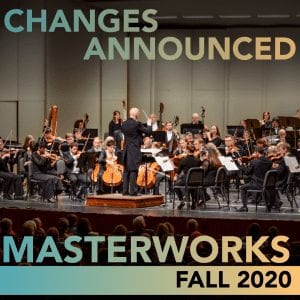
The QCSO has made many changes this year to concerts, in concert with its coronavirus task force.
“Our musicians are being flexible, and everybody’s being flexible, which is necessary,” Smith said. “People feel like this is worth it. They’d much rather have virtual concerts than no concerts. They’d much rather see their beloved musicians of the Quad City Symphony on their television screens, their computer screens, than not at all.”
Performing in an empty hall is certainly different.
“Of course, we connect with the audience and feel their electricity, when everybody’s holding their collective breath – that’s a magical thing,” Smith said. “But now, just knowing, the focus is a little different. Now, it’s just a different vibe in a way. I don’t think it’s going to be more relaxed. We will expect the best of ourselves. Now, we have to communicate that not just to the vibrations in the eardrum, but it’s through electronic means and visual means.”
“It’s definitely different without an audience there, and I hope the energy will be the same,” he said. “These players are great and super passionate, so I’m expecting the best.”
The only difference with the size of the Beethoven orchestra now, versus normal times, would maybe be fewer strings, Smith said. The First Symphony in Beethoven’s time probably had a smaller orchestra than the QCSO had last month.
“Being so far apart from each other is the weird thing – the numbers aren’t that different,” the conductor said. Musicians being separated does make a difference.

The 40-member orchestra was spread out on the Adler stage.
Of course, it’s better to be close together and you can watch each other more, hear each other better,” Smith said. “But people adjusted remarkably well, it was amazing. It just presents different challenges, for me too. I mean, my God, the basses are 10 miles away. It’s not like that in the regular orchestra.”
“People do adjust – I have to adjust and all the musicians have to adjust,” he said. “It’s not without its challenges, but it’s certainly not untenable.”
At the University of Minnesota-Twin Cities (where he’s director of orchestral studies), Smith is meeting with the orchestra in person, and recording performances without audiences, similar to the QCSO. “We’ve done two concerts successfully and there’s been no outbreaks,” he said.
A new study by University of Minnesota College of Science and Engineering researchers has found that wind instruments typically do not spread aerosols farther than one foot. The researchers suggest that mitigation strategies including social distancing, putting masks over instruments, and using portable filters can help reduce the risk of spreading Covid-19 on musical stages.
The U of M team is working closely with the Minnesota Orchestra. These findings are helping the orchestra establish and refine measures for maximizing the safety of its musicians during rehearsals and performances and could provide new insights for orchestras and bands worldwide.
Smith was named Artistic Director of the Greater Twin Cities Youth Symphonies in the fall of 2012 and has served as Artistic Director of Orchestral Activities at the University of Minnesota since 2007.
From Midori to Naha
The Masterworks II program Saturday features Bela Bartok’s Divertimento for Strings and Ludwig van Beethoven’s Violin Concerto, which
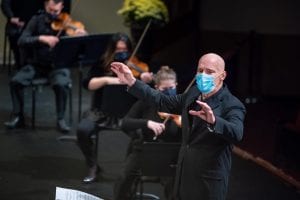
Smith conducted the QCSO in mask in October.
will spotlight QCSO concertmaster Naha Greenholtz.
The last time Smith led the Beethoven Violin Concerto in Davenport was with the world-renowned Midori as soloist, in 2011. “I do have fond memories of that, I do,” he said. “I have lots of fond memories of this concerto. And a young Heifetz played it here in the Quad-Cities.
“Naha was like, ‘Yikes,’” Smith said. “It’s had some epic performances.”
The first QCSO performance of Beethoven’s violin concerto was in 1939, featuring none other than the legendary Jascha Heifetz, with Oscar Anderson conducting. It’s has been featured a total of seven times prior to 2020, notably for an Iowa Public Television broadcast with Miriam Fried in 1980.
Perhaps because he himself could not serve as soloist, Beethoven’s 1806 concerto did not enjoy the same early success that did his five piano concertos, according to QCSO program notes. Having premiered his Symphony No. 3 at a benefit concert of the violinist Franz Clement,
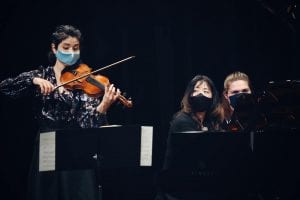
Violinist Naha Greenholtz often performs with pianist Marian Lee.
Beethoven wrote the violin concerto for Clement a year later.
It initially had a mediocre audience reception, partly due to its length — at about 50 minutes, it is longer than Beethoven’s longest piano concerto. Whatever the reason, it wasn’t until 1844, nearly two decades after Beethoven’s death, that then-12-year-old violinist Joseph Joachim performed the work in London with Felix Mendelssohn conducting, bringing delayed acclaim and cementing the concerto in the repertoire, the QCSO program says.
The work did receive something of a special reception during Beethoven’s lifetime, not as a violin concerto, but in an arrangement for piano and orchestra, commissioned by pianist Muzio Clementi. Although Beethoven did not write his own cadenzas for the original violin concerto premiere, he did provide piano cadenzas for the Clementi version, which have since been re-arranged into violin cadenzas.
Greenholtz will perform one of these arrangements for the first movement cadenza; her third-movement cadenza was composed by violinist Fritz Kreisler.
As for the Bartok, it premiered in 1940 in Basel, Switzerland. Though this is the first performance of Bartok’s Divertimento on a Masterworks concert, musicians from the QCSO performed the work in 2019 at a crossover concert with indie artist Har Mar Superstar at The Rust Belt, East Moline.
It’s not easy bein’ Greenholtz
In addition to her duties as concertmaster of both the Madison (Wis.) and Quad City Symphony Orchestras, Greenholtz’s past performance highlights include guest concertmaster appearances with the Oregon, Omaha, and Memphis Symphonies, the San Francisco Ballet, as well as
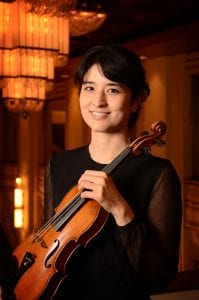
Greenholtz, a native of Kyoto, Japan, has been QCSO concertmaster since 2012.
the Calgary and Louisiana Philharmonics, among many others. In 2019, she appeared as guest concertmaster with the Chicago Philharmonic, in collaboration with the English National Ballet.
“It’s been a steep learning curve to communicate while wearing masks and to negotiate the extra space between string players,” the violinist and native of Kyoto, Japan, said this week by e-mail. “It takes longer for information to travel through air rather than fellow musicians, but the opportunity to connect with others absolutely makes the necessary flexibility and adapting to circumstances worthwhile.
“There were many months this spring when I didn’t know when I might get to perform again, so I’m thrilled that the QCSO has been able to offer safe concerts this season,” Greenholtz said. “I find it difficult to perform with a mask as much is lost in facial expressions.”
The QCSO had to call off the planned Beethoven Ninth (“Choral”) Symphony to kick off October, but Smith is not sure when in the future it’ll be rescheduled.
All this fall – like orchestras worldwide – the Q-C Symphony is celebrating the 250th anniversary of Beethoven’s birth (Dec. 17, 1770). Greenholtz played a special Signature Series concert Oct. 23 at the Figge Art Museum, with pianist Marian Lee.
The program featured Mozart’s rich Sonata in G Major, followed by Jesse Jones’ “Scherzo” (after Beethoven), inspired by the rapid-paced

Greenholtz will perform the Beethoven Violin Concerto Nov. 7 at the Adler.
aspects of Beethoven’s music, and closed with Beethoven’s mysterious and passionate Sonata No. 7 in C Minor.
The Figge concert was done with a limited and masked in-person audience and live streaming. “The lobby is a beautiful space and felt very alive with the large scale art installations and dedicated patrons,” Greenholtz said.
The “Scherzo” by the 42-year-old Jones “is a cheeky and light-hearted whirlwind of a piece based on a tune from a Beethoven piano sonata,” she said. “It’s a great counterweight to more standard works of Mozart and Beethoven as it stretches a well-worn and familiar form like the theme and variation to its limits with a wink and a nod.”
The chamber concert will air this Sunday, Nov. 8 at 7 p.m. on WVIK 90.3 FM, and is available on video through Nov. 23 at qcso.org.
Greenholtz said that the QCSO moving to no audiences and filmed concerts “feels like adding another in the list of things I’m learning to be flexible about. There are a couple perks, like my family in Vancouver and other distant folks being able to tune in, and I’m looking forward to experimenting with dynamics and acoustics in this new format.”
“I feel lucky to still be able to share great music in the Quad-Cities,” she said. The digital access for the Oct. 23 concert is $25 per household and $40 for the Masterworks concerts. For more information, call 563-322-7276.



